Between weeds, untreated sewage and commercial prawn culture, Chilika lake has had its bit of a struggle for survival. On World Environment Day, we take a look at its journey.
Written by Vishal Rasal
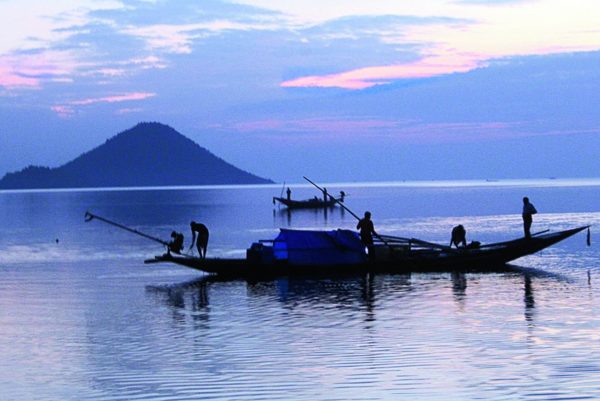
Chilika Lake © Ashwinee Pati
Long ago, long before the history we know, mountains were believed to have wings. They could fly at the speed of the mighty eagle. Filled with pride they started harassing birds. The birds then went to Indra, the king of the Gods, and complained against the mountains. Angry Indra cut off the wings of the mountains with his Vajra thunderbolt. All of them dropped from the sky and started crying. Their tears accumulated and formed a large lake that we know by the name of Chilika.
This one, of the many folk stories, is popular among villages on the banks of the lake. These stories are a metaphor of the deep relationship between the local community and Chilika Lake.
Paleo-geological evidences disagree with myths and link the lake’s existence to the Bay of Bengal receding due to a drop in water level about 3500 to 4000 years ago due to geo-climatic changes. It is the largest brackish water lake/ lagoon in Asia, situated between latitude of 19°28' to 19°54' North and longitude of 85°5'20" to 85°38'20" East. The spread of water varies between 1165 in monsoon to 906 km2 in summer.
Depth also varies from 1.73 to 3. 7 meters (monsoon) and 0.93 to 2.6 meters (summer).
A balanced system
The ecosystem of Chilika is in delicate balance, like a well-choreographed symphony orchestra. Two key factors are in play; one, the freshwater and sediment discharge by 52 distributaries of Mahanadi river system and two, marine water supply from the Bay of Bengal. The lake is connected to the Bay of Bengal by a 32 km long and 1.5 km wide channel that runs almost parallel to the Bay, separated by a narrow opening whose width varies between 100 m to few kilometres. Both water sources differ significantly in their salinity and nutrient composition.
Based on the influence of water from these two systems, the lake can be divided into four sections - northern zone, central zone, southern zone and an outer channel. A number of islands are present in the lagoon, some with habitation and some without. Different environmental conditions in each zone provide a niche to diverse organisms and makes Chilika, a treasure trove of biodiversity.
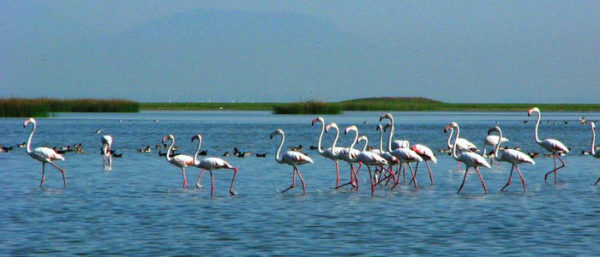
© Patra
Birds and aquatic life
Every winter the lagoon attracts nearly two million migratory birds from Central Asia and Himalayas. It is the largest wintering ground for migratory birds in the Indian subcontinent. It is one of the two lagoons in the world that supports a population of Irrawaddy Dolphins (Orcaella brevirostris). Barkudia insularis, a limbless skink, is found only in the shrub forests around Chilika. The diverse and dynamic assemblage of fish, invertebrate and crustacean species provides the basis of rich fishery. In 1981, Chilika was declared India’s first Ramasar site (as a Wetland of International Importance under the Convention on Wetlands).
Chilika supports 73 species of commercially important fishes, prawns and crabs. With annual average harvest of 11,958 tonne (average 2001-15) it provide livelihoods and food security for 0.14 million people living in 152 villages.
Any change in equilibrium between water supply from rivers and the bay has a cascading effect on salinity, siltation and distribution of organisms in the lake. Since 1970s, growth of human population, agriculture and reduction in vegetation cover in the catchment area of the lake due to heavy sedimentation in the lake, has resulted in the rapid shrinking of the lake area, reduction in depth and choking up the inlet channel essential for marine water supply. It rapidly reduced the salinity and increased the nutrient concentration.
Invasive aquatic plants Viz. Eichornia crassipes, Pistia stratiotes took advantage of the situation and rapidly proliferated in the northern sector of lake which is the freshwater zone. Between 1985-86 and 1998-99 the fish catch in the lake reduced by more than 90%. These changes led to severe loss of fisheries and allied livelihood.
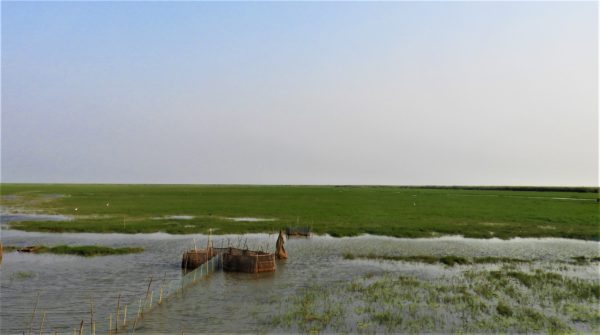
© Paromita Ray
Intensive prawn culture
Around early 80s, intensive commercial prawn culture was introduced in the lake and the government promoted it for economical upliftment of the people. High quantities of protein rich food is added in the water for fast growth of prawns. This excess of fish feed results in water pollution. Antibiotics are also added to avoid spread of diseases in high density stock of prawns, and this has harmful effects of wild fishes and those who consume them. Intense aquaculture also produces effluent that pollutes the water. Being a capital intensive business, which the local fishing community could not afford, many private companies and people from non-fishing communities invested heavily in this lucrative business. These events were catastrophic for the livelihood of the fishing community around the lake. It not only broke down the traditional community managed system, but also seriously damaged the lake ecology.
Even today, prawn culture is one of the biggest threats to the lake. Both legal and illegal prawn ponds occupy around 6000 hectare area which is approx. 19% of available area under brackish water.
The fishing community around Chilika had developed social and cultural institutions for sustainable harvesting from the lake. Different communities had fishing rights in different sections of the lakes. Specific crafts and gears used by specific community provided niche for everyone and avoided overexploitation. ‘No fishing’ period was also followed during breeding season of the fishes. The system was efficiently managed by social institutions such as the caste panchayat and village panchayat. This system suffered a serious blow from the introduction of the commercial prawn fisheries.
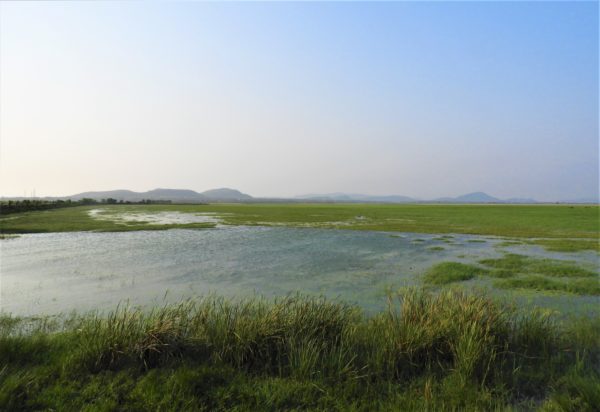
© Paromita Ray
Considering the loss to ecosystem and livelihood of the people dependent on the lake, the Government of India requested that Chilika lake be listed under Ramsar Convention’s Montreux Record in 1993. It is a list of threatened wetlands in need of urgent ecological restoration. The request was accepted and Chilika placed in the list.
In 1991, the Chilika Development Authority (CDA) was established by the Government of Odisha as the nodal agency to undertake measures for ecological restoration of the lake. The lake authority conducted detailed studies of lake ecology and hydrology to formulate the conservation strategies.
In 2000, on the basis of the hydrological studies, the authority took a major step and dredged a new mouth to increase the sea-water supply into the lake. This intervention restored the salinity gradient to a great extent and restored the fisheries in the lake. The number of Irrawaddy Dolphins also steadily increased between 2003 and 2014. The sea grass meadows, which are a good indicator of recovering ecosystem expanded from 20 km2 in 2000 to 80 km2 at present. In 2002, Chilika became the first and the only wetland in Asia to be removed from the Montreux record of threatened wetlands.
While all these changes were happening in the south and central parts of the lake, things were not as good in other parts of lake. Though the spread of the water hyacinth Eichhornia was drastically reduced after the opening of the sea mouth, the problem resurfaced in another form -- invasion by Phragmites karka, a species of sedge. Dredging balanced the salinity related issue in the lake to a large extent. But the problem of high level of sedimentation and nutrients remained unanswered.
Phragmites can tolerate high level of salinity and took advantage of the reduced depth and increased level of nutrients. Satellite imagery has shown that the area under Phragmites is approx. 286 km2. The dense growth of Phragmites is retaining more and more sediments and further aggregating the problem. It is rapidly replacing the area under submerged aquatic plant which is an important food source as well as breeding ground for fishes. Some species of water birds have also been observed to avoid dense stands of Phragmites.
Apart from these major threats, there are issues like sewage from villages and small towns around the lakes being directly released into the lake. Sand mining and poaching of the birds in the lake, ill-managed dolphin tourism, etc are also a cause of concern that has to be addressed.
Chilika is not just a unique water body but is an essential part of the livelihood and culture of thousands of people, directly and indirectly dependent on it. We are living in a very unique time, known as anthropocene, where humans have become the dominant force responsible for changes on earth systems. We have witnessed death of huge ecosystems which was unimaginable in past. Mighty rivers like Indus and Colorado are no longer reaching the sea. Big lakes like Aral sea and Lake Chad are on their deathbeds as a result of human induced changes. If we fail to act now, Chilika too will face a similar fate. There is dire need for a long term conservation action plan with the involvement of local community to ensure the survival of the lake, its ecosystem and the people.
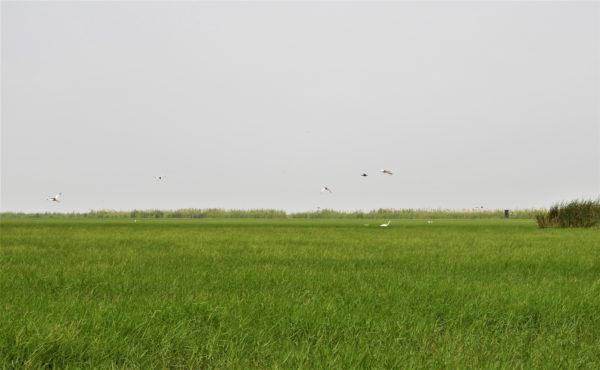
© Paromita Ray
PS: The recent cyclone Fani that ravaged the coast of Orissa also affected the Chilika. It has opened up four new mouths in the lake. Salinity in the lake is bound to increase. It will take a few weeks to assess the effects of cyclone on the lake ecosystem.